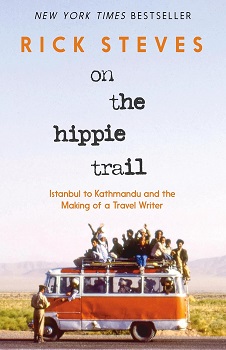On the Hippie Trail: Istanbul to Kathmandu and the Making of a Travel Writer by Rick Steves
Most folks in Whatcom County are familiar with Edmonds native and travel advocate, Rick Steves, whether from using his popular travel guides, watching his travel show “Rick Steves’ Europe,” hearing him speak at events (including Cascadia Daily News’ October 2024 town hall) or going on one of his tours.
Steves is known for a travel ethos that espouses international travel “as a way to better understand and contribute to the world in which we live,” choosing less-frequented destinations and seeking out experiences that foster immersion in local ways of life.
The origins of the Rick Steves travel brand trace back to one of his earliest adventures: a 3,000-mile overland journey undertaken with his friend Gene Openshaw in the summer of 1978. “On the Hippie Trail: Istanbul to Kathmandu and the Making of a Travel Writer” publishes Steves’ lightly edited journal entries and photographs from that trip, long in storage but rediscovered when he went through his archive while stuck at home in Edmonds during the pandemic.
Steves, then 23 years old and a recent history graduate from the University of Washington, was teaching piano and wondering what to do next. He’d felt a calling to go to India for years but had instead chosen to return to Europe for four consecutive summers of backpacking. Now, it was time.
The duo packed light, making exceptions only for the big hardbound journal, Pentax K1000 camera, and enough film canisters to support taking nine photos a day.
While in India, Openshaw and Steves rode a bus to the end of the line and found themselves in a village without cars, paved roads or other English speakers. Walking through the streets waving at people got them invited into a hut where they were offered tea, shared their package of biscuits, and smiled and babbled away although having no words in common. This is just one example of Steves’ “make things happen” philosophy combined with his friendly, gregarious personality opening doors to friendship and connection.
Another tenet of Rick’s Travel Philosophy is that “globetrotting destroys ethnocentricity … it broadens perspectives and teaches new ways to measure quality of life.” The journal entries in “On the Hippie Trail” show a young man becoming aware of his ethnocentricity and beginning to codify the ways travel can foster a sense of global citizenship.
Because the 1979 Iranian Revolution and the Soviet invasion of Afghanistan closed the overland route to Asia, 1978 was the last year of the Hippie Trail so the journal is an ode to this history as well. Not only was their trip the adventure of a lifetime, but it also had a life-altering aftermath. Upon returning to Seattle, Steves wrote his first travel book (“Europe Through the Back Door”) and opened a storefront business in Edmonds where he held travel classes, slide show presentations, and organized tours. The rest is history!
Photographs and reproduced pages of Steves’ actual journal bring this engaging armchair adventure to life. Whether you pick this book up to learn more about one of the Pacific Northwest’s iconic figures or the history of the Hippie Trail, or just to be inspired to travel, you’ll be rewarded with a vicarious experience (or reminder) of how it feels to be young, free of responsibility and open to all possibilities.
Lisa Gresham is the collection services manager for the Whatcom County Library System, wcls.org.
(Originally published in Cascadia Daily News, Tuesday, July 15, 2025.)

